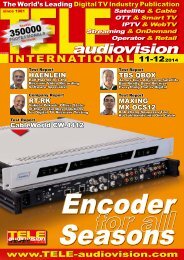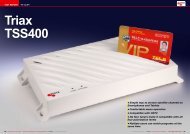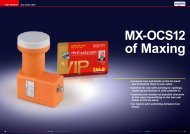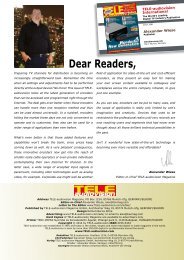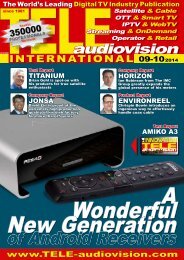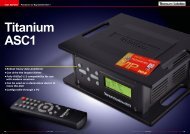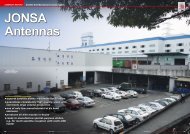MX LNBs of Maxing Electronic Technology
Create successful ePaper yourself
Turn your PDF publications into a flip-book with our unique Google optimized e-Paper software.
TEST REPORT<br />
Ku band <strong>LNBs</strong><br />
<strong>MX</strong> <strong>LNBs</strong> <strong>of</strong><br />
<strong>Maxing</strong><br />
• Single and Quad <strong>LNBs</strong> excellent for receiving<br />
weak satellites<br />
• Twin LNB ideal solution for strong satellites<br />
and extensive distribution systems<br />
• excellent workmanship<br />
• performance equal to other best quality<br />
<strong>LNBs</strong> on the market<br />
<strong>Electronic</strong><br />
<strong>Technology</strong><br />
54 TELE-audiovision International — The World‘s Leading Digital TV Industry Publication — 09-10/2014 — www.TELE-audiovision.com<br />
www.TELE-audiovision.com — 09-10/2014 — TELE-audiovision International — 全 球 发 行 量 最 大 的 数 字 电 视 杂 志 55
TEST REPORT<br />
Ku band <strong>LNBs</strong><br />
Good For Strong<br />
and Weak Satellites<br />
We have already presented<br />
one LNB <strong>of</strong> <strong>Maxing</strong><br />
<strong>Electronic</strong> <strong>Technology</strong> – the<br />
MB04 universal LNB for Ku<br />
Band with an integrated DiS-<br />
EqC switch (see TELE-audiovision<br />
07-08/2014). This<br />
time we picked some other<br />
<strong>LNBs</strong> <strong>of</strong> their huge collection<br />
<strong>of</strong> models, namely the more<br />
commonly used versions <strong>of</strong><br />
Single, Twin and Quad <strong>LNBs</strong><br />
for Ku Band. <strong>Maxing</strong> gave<br />
them these model names:<br />
<strong>MX</strong>-16, <strong>MX</strong>-KT22C and <strong>MX</strong>-<br />
KQ24C respectively.<br />
The <strong>LNBs</strong> we put to our<br />
test bench this time looked<br />
from the outset typical for<br />
Ku Band <strong>LNBs</strong>. They were<br />
finished <strong>of</strong>f very well. The<br />
only small drawback we noticed<br />
was that their labels<br />
were made <strong>of</strong> paper. So,<br />
you can not expect them to<br />
survive long when installed<br />
outside on a dish. However,<br />
do you really care?<br />
Once installed, you usually<br />
do not pay any more attention<br />
to the LNB on your dish.<br />
Even if the label is eventually<br />
peeled <strong>of</strong>f by rain and<br />
wind this will not trigger any<br />
problem or esthetic discomfort.<br />
That’s why we do not<br />
regard this as a serious imperfection.<br />
What really counts is the<br />
performance. We decided<br />
to use our Toroidal multifeed<br />
dish with 8 <strong>LNBs</strong>. For<br />
the purpose <strong>of</strong> this test we<br />
replaced one <strong>of</strong> its <strong>LNBs</strong><br />
with one by one the <strong>Maxing</strong><br />
<strong>LNBs</strong>. The original LNB<br />
served as the reference to<br />
which the <strong>Maxing</strong> <strong>MX</strong> <strong>LNBs</strong><br />
were to be compared to. You<br />
should know that it was a<br />
low noise (NF=0.2 dB) contemporary<br />
LNB <strong>of</strong> very good<br />
quality. We decided to use<br />
the LNB poiting to the AS-<br />
TRA satellite on 19.2 East.<br />
Although this satellite was<br />
very strong in our location,<br />
it did not necessarily mean<br />
that the test was easier to<br />
pass.<br />
In such environment<br />
(Toroidal dish and strong signals)<br />
you may expect quite<br />
some interference from<br />
neighboring satellites so additional<br />
to the low noise figure<br />
the LNB under test must<br />
also <strong>of</strong>fer a low phase noise,<br />
high cross polarization isola-<br />
09-10/2014<br />
MAXING <strong>MX</strong>-16, <strong>MX</strong>-KT22C, <strong>MX</strong>-KQ24C<br />
Excellent workmanship give excellent<br />
reception results<br />
www.TELE-audiovision.com/14/09/maxing<br />
tion and high resistance to<br />
intermodulation. The most<br />
practical way to evaluate all<br />
those parameters at once<br />
is to compare the LNB under<br />
test to another one <strong>of</strong> a<br />
different brand. And that’s<br />
what we did.<br />
As usually, we compared<br />
the LNB power output which<br />
is directly related to signal<br />
strength and Modulation<br />
Error Ratio (MER) which in<br />
turn is related to the signal<br />
quality. The first two graphs<br />
present the signal strength.<br />
Evidently, the <strong>MX</strong>-16 was<br />
weaker than our reference,<br />
the <strong>MX</strong>-KT22C was visibly<br />
stronger and the <strong>MX</strong>-KQ24C<br />
was more or less equal.<br />
56 TELE-audiovision International — The World‘s Leading Digital TV Industry Publication — 09-10/2014 — www.TELE-audiovision.com
What is worth mentioning,<br />
both outputs <strong>of</strong> the Twin LNB<br />
and all four outputs <strong>of</strong> the<br />
Quad LNB were almost identical.<br />
So none <strong>of</strong> the outputs<br />
was weaker or stronger than<br />
the others with the same<br />
LNB.<br />
Then we measured and<br />
processed the MER results.<br />
And here we had another<br />
picture. We may say that<br />
the <strong>MX</strong>-16 matched our reference,<br />
the <strong>MX</strong>-KT22C was<br />
somewhat worse and the<br />
<strong>MX</strong>-KQ24C was again almost<br />
equal to the reference.<br />
The reason for this is<br />
clear: the <strong>MX</strong>-KT22C has<br />
been designed as a high<br />
output LNB and due to that<br />
its noise performance is not<br />
as good as the normal output<br />
level companions (Single<br />
and Quad in this case), whch<br />
is due to increased intermodulation<br />
in such high gain<br />
LNB. However, this makes<br />
this LNB a favorite for receiving<br />
strong satellites<br />
connected to a distribution<br />
system with significant signal<br />
loss due to long cables<br />
or many switches.<br />
The <strong>MX</strong>-16 and <strong>MX</strong>-KQ24C<br />
did not have such a strong<br />
output signal but performed<br />
very well in signal quality<br />
measurements. We can<br />
recommend them even for<br />
difficult reception conditions.<br />
They they perform as<br />
well as the best <strong>LNBs</strong> on the<br />
market.<br />
Finally, we measured current<br />
consumption <strong>of</strong> all<br />
<strong>LNBs</strong>. Here are the results:<br />
<strong>MX</strong>-16—72 mA<br />
<strong>MX</strong>-KT22C—104 mA<br />
<strong>MX</strong>-KQ24C—152 mA.<br />
The d.c. currents are quite<br />
reasonable and similar to<br />
other devices <strong>of</strong> this kind.<br />
They will not cause any<br />
problem for any receiver or<br />
multiswitch.<br />
expert<br />
OPINION<br />
+ ● Excellent noise performance <strong>of</strong> the Single and Quad <strong>LNBs</strong>:<br />
<strong>MX</strong>-11 and <strong>MX</strong>-KQ24C<br />
● Very strong output <strong>of</strong> the Twin LNB: <strong>MX</strong>-KT22H<br />
–<br />
● lables made <strong>of</strong> paper<br />
MAXING <strong>MX</strong>-16,<br />
<strong>MX</strong>-KT22C, <strong>MX</strong>-KQ24C<br />
Ku band <strong>LNBs</strong><br />
■<br />
RECOMMENDED<br />
PRODUCT BY<br />
Jacek Pawlowski<br />
Test Center<br />
Poland<br />
TELE-audiovision already tested the<br />
MB04, a LNB with integrated DiSEqC<br />
switch<br />
http://www.tele-audiovision.com/<br />
TELE-audiovision-1407/eng/maxing.pdf<br />
58 TELE-audiovision International — The World‘s Leading Digital TV Industry Publication — 09-10/2014 — www.TELE-audiovision.com<br />
www.TELE-audiovision.com — 09-10/2014 — TELE-audiovision International — 全 球 发 行 量 最 大 的 数 字 电 视 杂 志 59




